Think of an all terrain electric scooter as the 4x4 of the scooter world. It’s a beast built to chew up rough surfaces like gravel paths, dirt trails, and grassy fields, not just glide along smooth city pavement. These rugged machines get their trail-shredding abilities from specialized parts designed for serious stability, power, and durability.
What Makes an Electric Scooter All Terrain?
It helps to think about the difference between a regular commuter scooter and an all-terrain model this way: a standard scooter is your dependable city sedan. It’s perfect for getting around on predictable, paved roads.
But an all terrain electric scooter? That's your Jeep Wrangler. It's built from the ground up to conquer the wild, unpredictable terrain that lies far beyond the city limits.
This isn't just clever marketing—it's a completely different design philosophy. A commuter scooter is all about being lightweight and easy to carry. An off-road model, on the other hand, throws that out the window in favor of raw power, a beefy frame, and a suspension system that can soak up some serious abuse. These aren't just minor tweaks; they're the very soul of the machine.
The Core Components of an Off-Road Machine
The real magic comes down to a few key ingredients that work in harmony to give you a stable, powerful ride, even when the ground beneath you is anything but friendly. Take away any one of these, and you’ll find yourself stuck in the mud—literally.
This infographic nails the essential trio of features that give an all-terrain electric scooter its go-anywhere DNA.
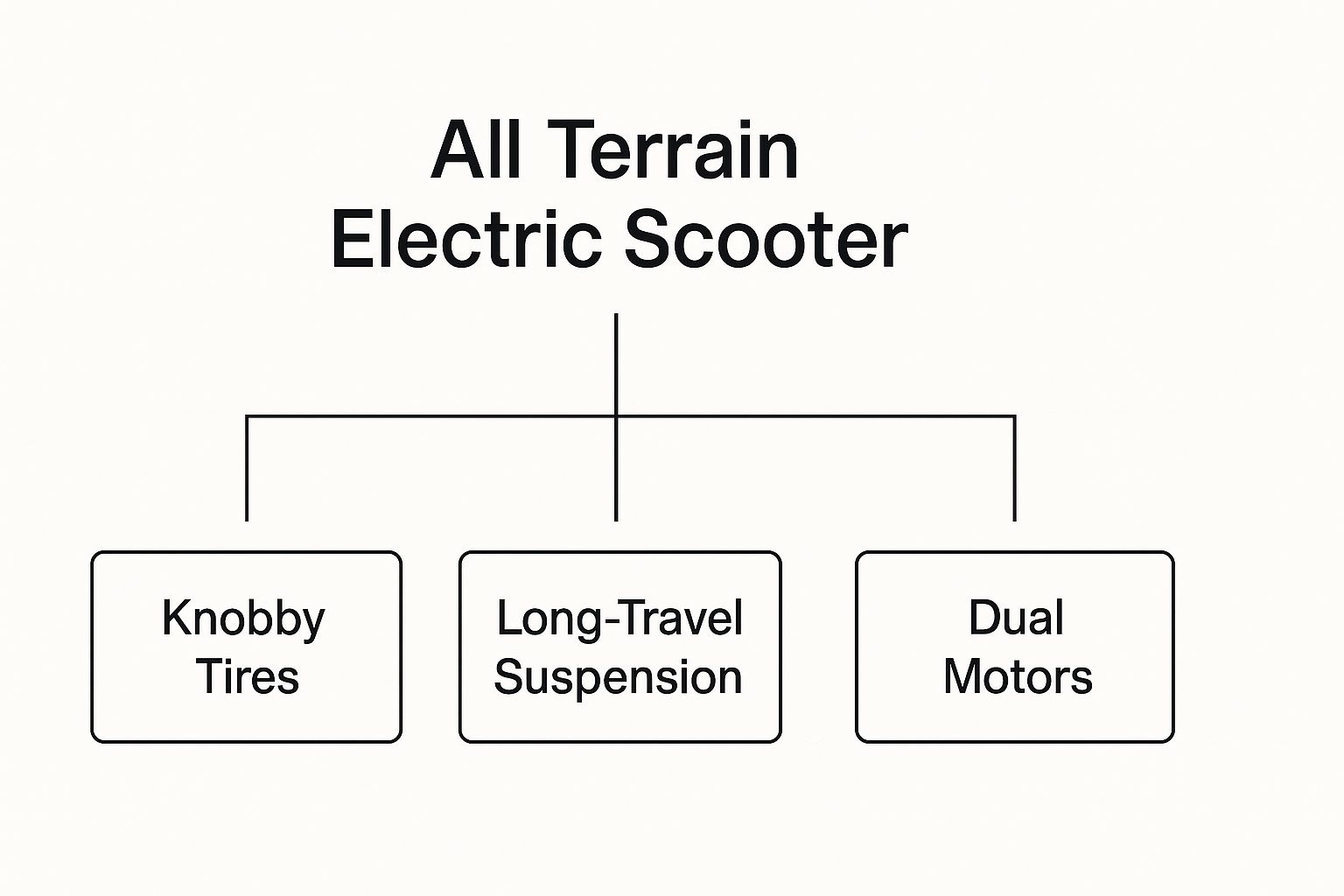
As you can see, it’s that holy trinity of knobby tires for aggressive grip, long-travel suspension for smoothing out bumps, and powerful dual motors for raw torque that truly makes a scooter an off-road machine.
And people are catching on. The global off-road electric scooter market is on track to hit around USD 990 million by 2025, with an expected growth rate (CAGR) of 4.8% all the way through 2033. This boom shows a real hunger for more adventurous and sustainable ways to get out and play. If you're curious, you can discover more insights about this expanding market and its future.
Anatomy of an Adventure Ready Scooter
Look, an all terrain electric scooter isn't just a regular scooter that's been painted to look tough. It’s a completely different beast, engineered from the ground up for serious business. Think of it less like a commuter vehicle and more like a mountain bike that met a dirt bike—every single part is chosen for performance and punishment.
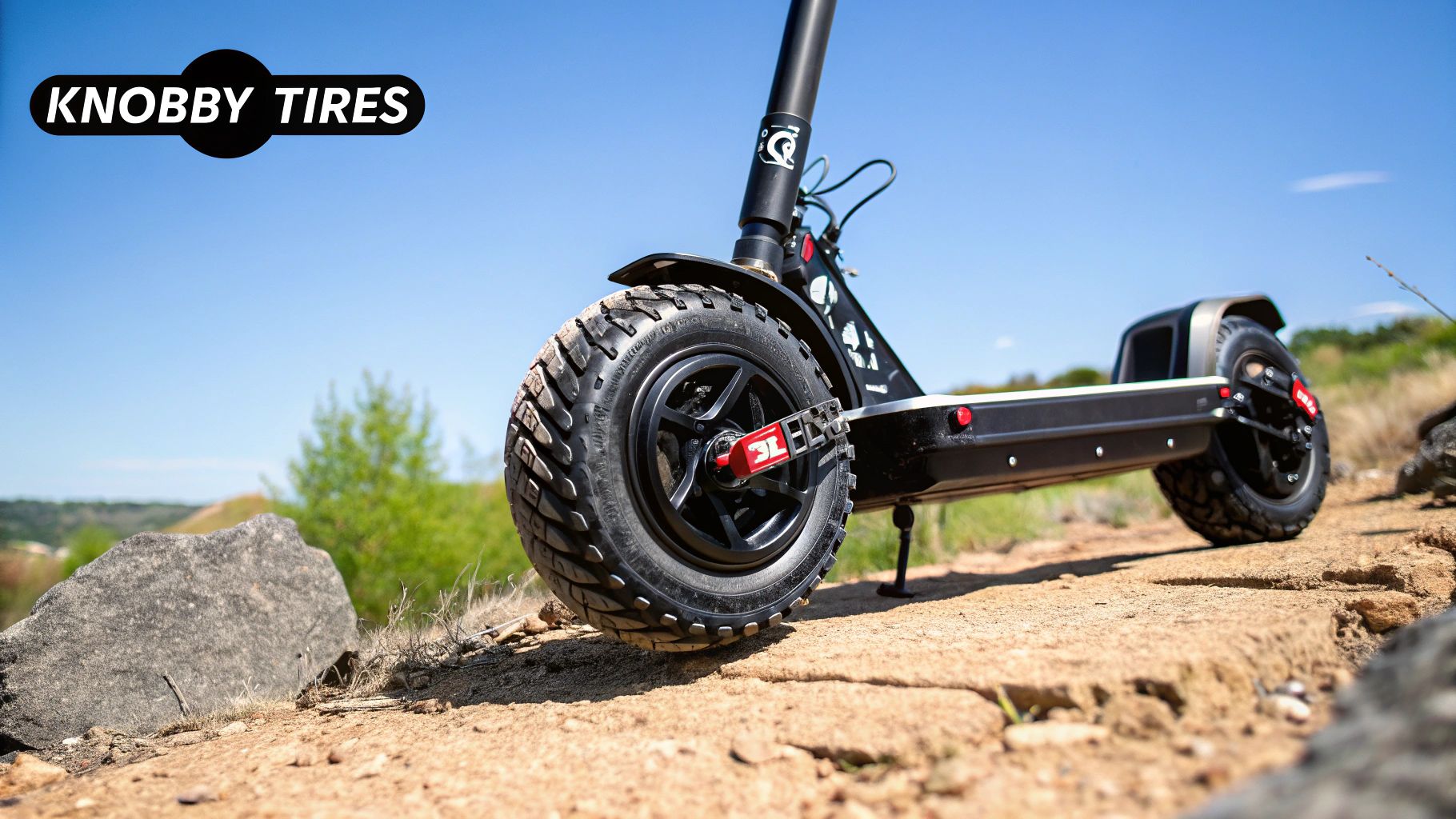
It all starts with the heart of the machine: the motor. Your average city scooter gets by with a single, polite little motor. But a true off-road scooter? It's often rocking dual motors, one driving each wheel. This isn't just for show. That setup delivers the raw, neck-snapping torque you need to scramble up a steep dirt hill that would have a standard scooter pathetically spinning its wheels.
All that power needs to be controlled, which is where a real suspension system comes in. Forget the bone-rattling ride of a basic scooter. All-terrain models use long-travel suspension, complete with beefy springs and shocks that you’d typically find on a downhill mountain bike. This is what lets you float over rocks, roots, and ruts, keeping you in control and the ride surprisingly smooth.
The Foundation of Off-Road Dominance
Of course, power and suspension mean nothing if you can't stick to the trail. That's the tires' job. An all terrain electric scooter ditches the slick city tires for big, chunky, knobby tires made to bite into loose surfaces. We’re talking dirt, gravel, grass—you name it. Those deep treads are what give you the confidence to lean into a turn or slam on the brakes when the ground is anything but predictable.
Dual motors, long-travel suspension, and knobby tires. These three things are the holy trinity of off-road scooters. If a scooter is missing even one, it's not a true all-terrain machine; it's just a city scooter playing dress-up.
Holding this all together is a reinforced frame. Built from heavy-duty alloys, the frame on one of these is designed to take a beating. It has to withstand the incredible stress from jumps, drops, and constant vibrations without twisting or cracking. For your safety and the scooter's lifespan, a burly frame is absolutely non-negotiable.
Finally, what good is an adventure if a dead battery cuts it short? These scooters are fitted with high-capacity battery packs for a reason. They have to feed two power-hungry motors over long, demanding rides, ensuring you’ve got enough juice to explore deep into the wilderness and, more importantly, get back home. Keeping these specialized parts in prime condition is crucial, and you can find great advice in our guide on electric scooter tire replacement to keep your ride rolling smoothly.
The difference between a standard scooter and an all-terrain model is night and day. Let’s break it down side-by-side to really see what you’re getting.
Standard vs All Terrain Electric Scooter Features
| Feature | Standard Commuter Scooter | All Terrain Electric Scooter |
|---|---|---|
| Motors | Single, low-power motor (e.g., 350W) | Dual, high-power motors (e.g., 1000W+) |
| Suspension | Minimal or no suspension | Full, long-travel hydraulic/spring suspension |
| Tires | Small, solid, or pneumatic street tires | Large, wide, knobby off-road pneumatic tires |
| Frame | Lightweight, designed for portability | Reinforced, heavy-duty alloy construction |
| Battery | Smaller capacity for city range | High-capacity for extended off-road range |
| Brakes | Basic electric/drum brakes | High-performance hydraulic disc brakes |
As you can see, every key component is upgraded for a completely different purpose. It's not about getting from A to B on pavement; it's about making your own path wherever you want to go.
Where Can an All-Terrain Scooter Actually Take You?
Sure, we can talk about technical specs and beefy components all day, but that’s only half the story. The real magic of an all-terrain electric scooter is the freedom it gives you. Think of it as a key that unlocks a world of adventure, taking you far beyond where a normal city scooter—or even your car—could ever go.
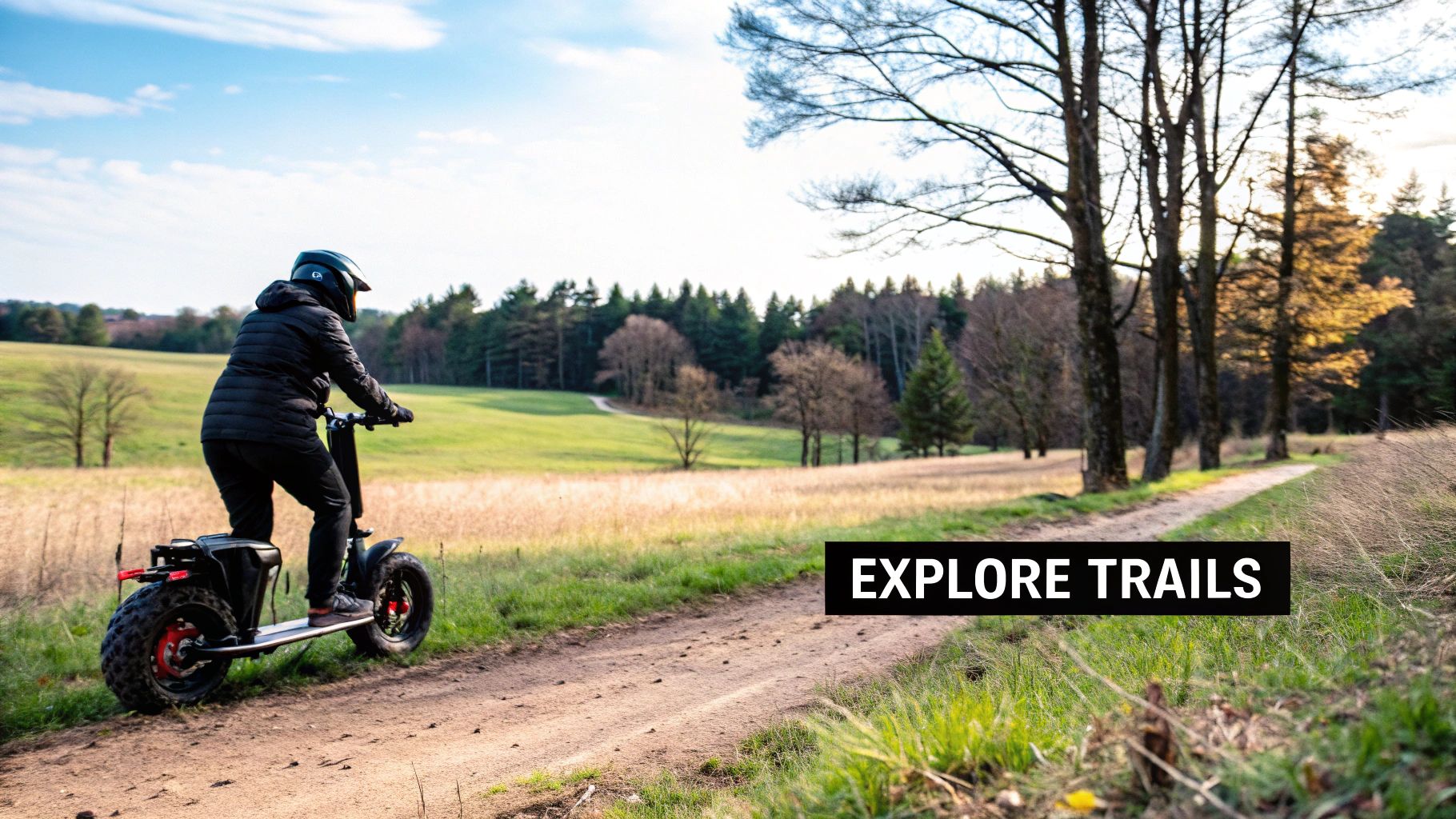
Picture this: instead of your usual weekend routine, you're out exploring the vast network of Bureau of Land Management (BLM) trails in the US or the fire trails crisscrossing Australian national parks. An all-terrain scooter lets you glide through forests and over rolling hills, soaking in miles of stunning scenery without breaking a sweat or shattering the peace and quiet.
It’s a completely different way to experience the outdoors, making exploration feel genuinely exciting and accessible again.
More Than Just Weekend Fun
But adventure isn't just for the weekends. The rugged nature of an all-terrain model can bring a little excitement and a lot of practicality to your everyday life.
-
Life on the Land: Got a large property, a ranch, or any kind of rural land? These scooters are a total game-changer. You can zip from one end to the other to check fences, carry tools, or just enjoy your space without any hassle.
-
The Perfect Campsite Vehicle: Forget trudging across sprawling campgrounds in places like Yosemite or the Blue Mountains. Quietly ride to the facilities, explore nearby trails, or pop over to the camp store without ever having to fire up the car. It’s brilliant.
-
The Commute with a Twist: If your daily journey involves gravel shortcuts, bumpy paths, or just poorly maintained roads, an all-terrain scooter turns those rough patches into the best part of your ride.
This is what really sets them apart. They’re not just toys for thrill-seekers; they are seriously practical tools that fit right into your lifestyle, whether you're working the land or just looking for a better way to get around.
An all-terrain electric scooter isn't about replacing your car; it's about going where your car can't. It’s for discovering those hidden paths, reducing your environmental footprint, and getting back a sense of pure, unscripted adventure.
Getting to the Places You Can't Reach
At the end of the day, the best place an all-terrain electric scooter can take you is somewhere just off the beaten path. You know those scenic viewpoints you can spot from the road but can never quite get to? Or that perfect lakeside spot that’s just a bit too far to walk with all your gear?
These scooters bridge that gap.
They give you the power to follow your curiosity down that interesting-looking dirt track or explore the network of trails crisscrossing your local woods. This is what real freedom feels like—turning a simple ride into a memorable expedition every single time you head out. It's about making the journey itself the destination.
So, What Do All The Numbers Mean?
Staring at a spec sheet for an all-terrain electric scooter can feel like you’re trying to decode a secret message. All those watts, volts, and amps can be a bit much, but they're the key to understanding how a scooter will actually feel when you're out on the trail. Let's break down what really matters.
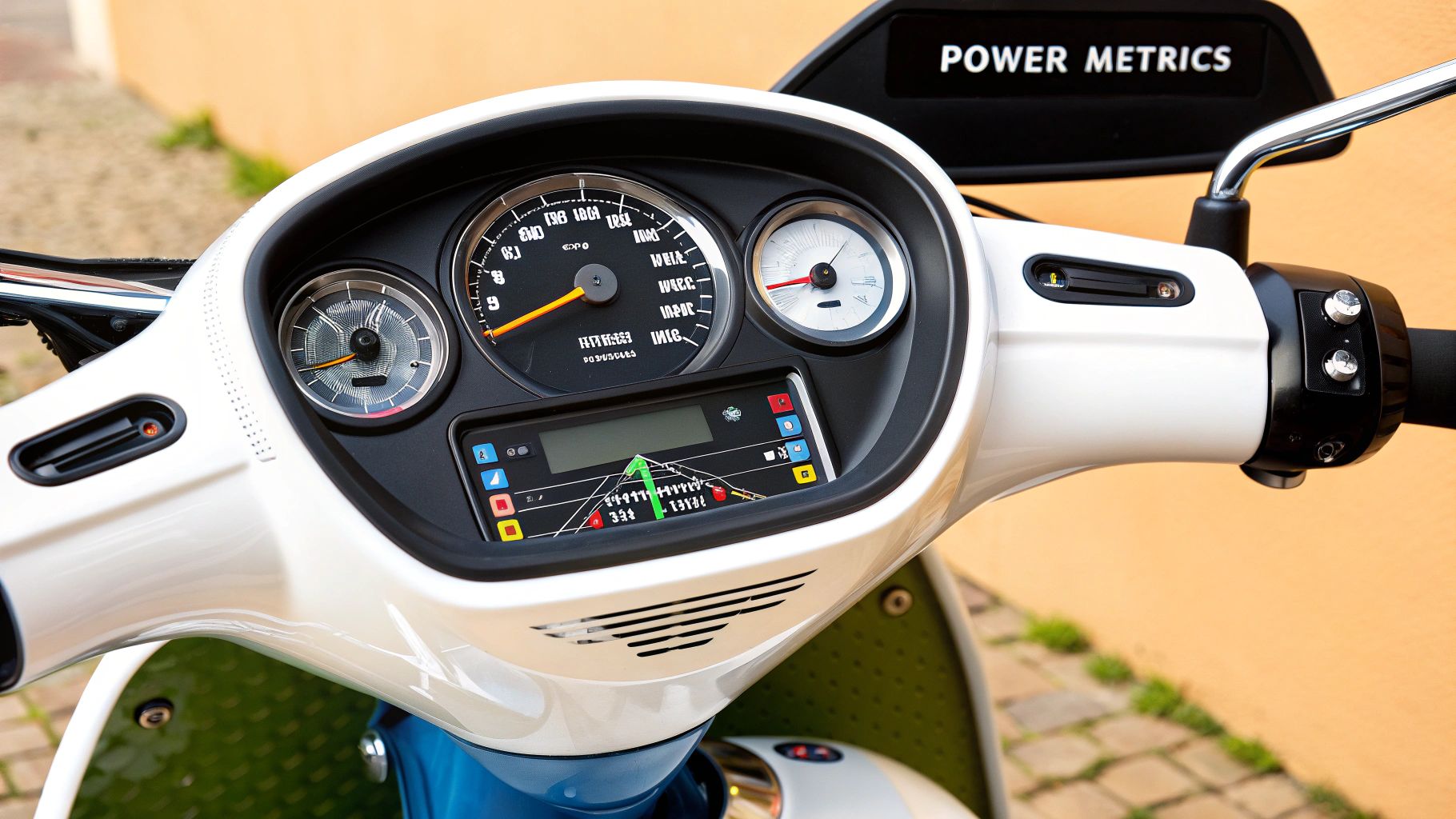
First up is motor power, which you’ll see measured in watts (W). Think of this as the raw muscle of your ride. Your average commuter scooter might hum along with a 350W motor, which is perfectly fine for flat city streets.
But when you’re staring down a steep, muddy hill, you need some serious grunt. That’s why all-terrain beasts often pack dual motors, pushing their combined power to 1000W and way beyond. This is what gives you that tire-gripping torque to claw your way up tough climbs.
It's All About Battery Power and Range
The battery is the heart of your scooter, dictating both how far you can go and how much punch you'll have along the way. Two numbers are your best friends here: Voltage (V) and Amp-Hours (Ah).
- Voltage (V): This is basically the horsepower. Higher voltage—say, 60V instead of 48V—sends more power to the motors. The result? Quicker acceleration and the oomph to make hills feel flat.
- Amp-Hours (Ah): This is your fuel tank. A bigger Ah number means the battery holds more juice, translating directly to a longer range before you have to plug in.
These two work hand-in-hand. A high-voltage system with plenty of amp-hours is the perfect recipe for a powerful scooter that won’t quit on you halfway through an adventure. If you want to get into the nitty-gritty, our guide on understanding electric scooter range breaks it all down.
Don't Ignore the IP Rating
No matter where you're riding, the IP (Ingress Protection) rating is one spec you absolutely cannot skip. This little two-digit code tells you exactly how well the scooter's delicate electronics are sealed against dust and water. The first number is for dust, and the second is for water.
A rating of IP54 is pretty common, meaning it’s protected from dust and can handle splashes from any direction. That's fine for crossing a shallow puddle or getting caught in a light shower.
But for a true, year-round, all-terrain machine, you’ll want something more robust like IPX5 or IPX6. Those ratings mean it can handle getting properly wet. Whether you're splashing through a creek in the Aussie bush or dealing with an unexpected downpour in the Pacific Northwest, a good IP rating is what ensures a sudden soaking doesn’t end your ride—or kill your scooter.
Knowing what to look for—motor watts, battery V/Ah, and the IP rating—is the difference between buying a scooter and buying the right scooter. It lets you see past the hype and understand what you're actually getting.
And it seems more people are catching on. The demand for these rugged machines is exploding, with the global all-terrain e-scooter market predicted to jump from USD 11.47 billion in 2024 to a massive USD 50.63 billion by 2035. It’s a clear sign that riders want more power and freedom.
How to Choose Your Perfect All Terrain Scooter
Ready to find your perfect off-road partner in crime? Picking the right all terrain electric scooter is about more than just which one looks the most epic. It’s really about matching the machine to your mission, your budget, and most importantly, where you're actually going to be riding it.
Think of it like buying a good pair of hiking boots. You wouldn't grab a pair of flimsy sneakers for a serious mountain trail, just like you wouldn't wear clunky climbing boots for a quick walk in the park. The same logic applies here. Taking a moment to answer a few questions will stop you from buying a scooter that can't handle your local hills or, on the flip side, an aggressive beast that's total overkill for gentle park trails.
Assess Your Terrain and Riding Style
First things first, get real about where you'll be riding. Are we talking mostly flat gravel paths and park trails? Or are you dreaming of tackling steep, muddy inclines out in the countryside? The gnarlier the terrain, the more you'll need to zero in on key specs like dual motors for raw power and a beefy battery that won't die on you halfway up a hill.
You also need to think about portability. A heavy, powerful scooter feels amazing on the trail but can be a serious pain to haul into a car or lug up a flight of stairs. If you need to mix your riding with other transport, a lighter model might be a much smarter choice.
For anyone riding in the US and Australia, knowing the local laws is a must. Rules can change dramatically not just between states, but even between cities and counties. Some areas might have specific speed limits or require helmets, while others may restrict scooter use to bike lanes or private property. Always, always check the latest local rules before you head out.
This legal stuff is a huge part of your decision—it makes sure you can actually use your scooter where you want to. The market is exploding, valued at around USD 36.4 billion globally in 2024 and set to keep growing as governments push for cleaner transport. But the laws for personal e-scooters are still playing catch-up. You can read the full research about this market growth to get the bigger picture.
Setting a Realistic Budget
Okay, let's talk money. All-terrain scooters cost more than your average commuter model, and for good reason. They're packing way more power, proper suspension, and parts built to take a beating. It’s tempting to just grab the cheapest one you can find, but that can be a classic case of false economy.
An entry-level model might just not have the guts for what you want to do, leaving you with a pretty frustrating ride. It's better to set a realistic budget based on what you actually need.
For a really detailed breakdown of what you get for your money, check out our guide on how to compare electric scooters. By balancing your terrain needs, how portable you need it to be, and your budget, you'll be able to lock in the perfect all-terrain scooter for all your adventures.
Your Questions, Answered
Jumping into the world of all-terrain electric scooters is exciting, but it's natural to have a few questions. We get it. You're about to invest in a serious piece of kit, and you want to know what you're getting into.
Let's tackle some of the most common things people ask before they pull the trigger.
Are All-Terrain Electric Scooters Legal?
This is the big one, and rightly so. E-scooter laws vary wildly depending on where you are. In the United States, regulations can differ from state to state, and even city to city. Some places treat them like bicycles, allowing them in bike lanes, while others have specific speed limits or helmet laws. In Australia, the rules are also state-based, with places like Queensland having more established frameworks for private e-scooter use than others.
The bottom line: It's crucial to check the specific regulations for your local area. A quick search for "[Your City/State] e-scooter laws" is the best way to stay informed and ride legally.
How Much Maintenance Are We Talking About?
An all-terrain scooter needs a bit more love than a standard commuter model, but don't worry, you don't need to be a professional mechanic. Since these machines are built to take a beating, a little proactive care goes a long way.
Think of it like this: a mountain bike needs more attention than a cruiser you only ride on the boardwalk. It's the same principle here.
- Tire Pressure: Check it before you head out. Every time. It’s the single best thing you can do to avoid pinch flats and keep a good grip on sketchy trails.
- Brakes: You’re going faster and stopping harder on rough terrain. Give the brake pads a regular look-over and make sure they feel sharp and responsive.
- Suspension: After a muddy ride, just wipe down the suspension forks and shocks. This simple step stops grit from grinding away at the seals and keeps things running smoothly.
- Bolts and Fasteners: Off-roading means vibrations, and vibrations can loosen things up. Give the key bolts a quick check every few rides to make sure everything's still snug.
This quick pre-ride checkup is a habit that pays off big time, keeping your scooter safe and running for years.
The biggest maintenance difference? It's all about the cleanup. A city scooter might get an occasional wipe, but an all-terrain model really needs a good clean after a dirty ride. Getting that mud and grit off protects all the moving parts from damage.
What’s a Realistic Off-Road Battery Range?
Ah, the million-dollar question. That "max range" you see advertised is usually tested under lab-like conditions—think a super-light rider on perfectly smooth, flat pavement. When you hit the dirt, that number is going to drop. That's totally normal.
Here’s what really eats up your battery life:
- The Trail Itself: Climbing steep hills, churning through mud, or bouncing over roots demands way more juice from the motors.
- Your Weight: More weight means the motors have to work harder, which uses more battery.
- How You Ride: Pinning the throttle and riding aggressively will drain the battery much faster than cruising at a steady pace.
- The Weather: Batteries just don't love the cold. On a chilly day, expect your total range to take a hit.
A safe bet is to plan for about 60-70% of the advertised range when you're truly riding off-road. Keeping that real-world number in mind means you can plan your adventures without the dreaded "range anxiety" and make sure you've always got enough power to get home.
Ready to start your next adventure? At Punk Ride LLC, we offer a curated selection of top-tier all-terrain electric scooters designed to take you anywhere. Explore our collection and find the perfect ride for your explorations.




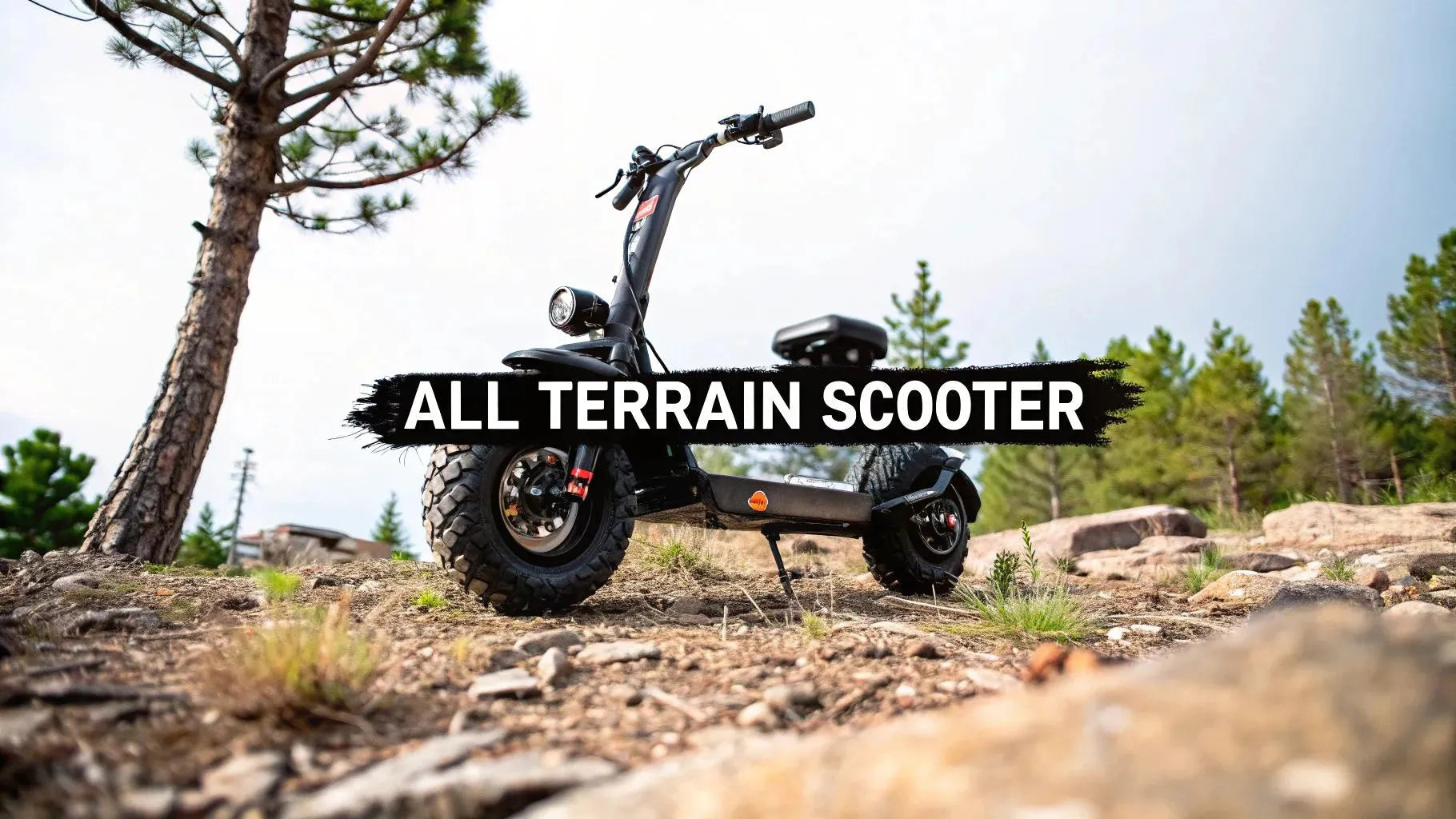
Share:
Electric Scooter Law California Explained
Electric Scooters for Adults Reviews | Find Your Ride